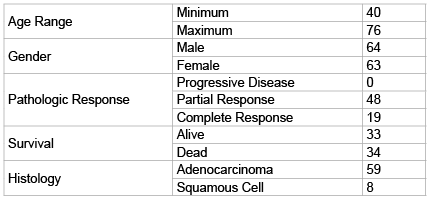
Table 1: Patient Characteristics
CR: Complete Response

Lilit Karapetyan1 Richard F Heitmiller2 Arlene A Forastiere3 Malcolm V Brock4 Elisabeth I Heath5 Michael K Gibson1*
1Department of Hematology/Oncology, University Hospitals Case Medical Center, Case Western Reserve University, Cleveland, Ohio, USA*Corresponding author: Michael K Gibson, Department of Hematology/Oncology, University Hospitals Case Medical Center, Case Western Reserve University, 11100 Euclid Avenue, Lakeside 1242, Cleveland, OH, USA, Tel: 216-844-0513; Fax: 216-844-5234; E-mail: Michael.Gibson@uhhospitals.org
Article Type: Research Article
Citation: Karapetyan L, Heitmiller RF, Forastiere AA, Brock MV, Heath EI, et al. (2016) Pathologic Staging with Taxane-based Neoadjuvant chemoradiotherapy Correlates with Increased Survival in Patients with Locally Advanced Esophageal Cancer. Int J Cancer Res Mol Mech 2(2): doi http://dx.doi. org/10.16966/2381-3318.125
Copyright: © Karapetyan L, et al. This is an open-access article distributed under the terms of the Creative Commons Attribution License, which permits unrestricted use, distribution, and reproduction in any medium, provided the original author and source are credited.
Publication history:
Background: The treatment of resectable stages of esophageal cancer often involves pre-operative concurrent chemoradiotherapy. This study aims to evaluate the effect of cisplatin/paclitaxel-based neoadjuvant chemoradiotherapy on pathologic stage and survival in patients with locally advanced esophageal cancer.
Methods: Patients (n=67) received cisplatin/paclitaxel-based induction chemoradiotherapy followed by esophagectomy. Survival calculated from time of surgery was stratified by pathologic stage and controlled for clinical factors.
Results: Clinical factors included: age (range 40 to 76 years); gender (64 male; 3 female); and histology (59 adeno; 8 squamous cell). Pretreatment stages were: IIA (n=2); IIB (n=8); III (n=49) and IVa (n=8). Treatment led to downstaging in 54 patients, and 19 patients achieved a pathologic complete response (pCR). Post-treatment (pathologic) stages were: 0 (n=19); I (n=6); IIA (n=26); IIB (n=7); III (n=6); IV (n=3). Median survival was 47.5 months with minimum follow up of 5 months for surviving patients. Number of stage reductions did not correlate with survival (p=0.83 by chi2 ), and 6/13 patients with no downstaging are alive at the time of analysis. Median survivals for each pathologic stage were: 0 (not reached); I (31 months); IIA (35 months); IIB (17 months); III (11 months); and IV (4 months)—[p <0.01 by logrank test]. In a Cox multivariate model adjusted for age, gender and histology, higher pathologic stage correlated with worse survival (HR 1.44; 95% CI 1.12-1.86).
Conclusion: Cisplatin/paclitaxel-based neoadjuvant chemoradiotherapy for resectable esophageal cancer leads to pathologic downstaging in most patients, and lower pathologic stage correlates with better survival.
Esophageal cancer; Neoadjuvant; Chemoradiotherapy; Pathological staging; Overall survival
Esophageal cancer comprises 1.5% of total cancer cases in the United States. From 2004-2013, the age-adjusted incidence of EC has decreased from 5.0 to 4.0 cases per 100,000 people in the United States [1]. Although squamous cell carcinoma accounts for 90% of cases of esophageal cancer worldwide, the incidence of adenocarcinoma has been drastically increased with the most common tumor location at the gastroesophageal junction and distal esophagus [2]. Regardless of histology, approximately 50-60% of patients present with incurable locally advance or metastatic disease. Unfortunately, despite recent achievements in cancer therapy, at most 10-15% of all patients presenting with esophageal cancer are cured [3]. For those with locally advance, non-metastatic disease, cure is achieved in up to 30% of patients when multimodality therapy is used [4,5]. A significant improvement in the survival rate is reported from the SEER database with a 5 –year survival rate of 18.4% for 2006-2012; however survival rates remain low [1,6].
The majority of patients at the time of diagnosis present with subclinical micro-metastatic disease, with tumor invasion at least into the muscularispropria (T2) and/or involvement of regional nodes (N1) or spread to celiac or cervical nodes (M1a) from a distal or upper thoracic primary, respectively. This multitude of factors explains why, despite treatment with aggressive surgical resection, the overall 5-year survival rates ranged from 15% to 22%. The local and distant metastases after surgery alone are common, and predominate in patients with adenocarcinoma [3].
The addition of chemotherapy (CT) and radiotherapy (RT) to the primary management of esophageal cancer has been tested in various combinations and sequences [5,7-11]. Treatment with CT early may reduce both loco-regional and micro-metastatic tumor burden, while RT may downstage tumor, sterilizing areas that will not be affected by surgery. When administered together in a concurrent fashion, chemoradiotherapy (CRT) exploits the ability of cytotoxics such as cisplatin and paclitaxel to enhance RT effects and prevent emergence of drug resistant clones.
Administering these therapies before surgery takes advantage of enhanced drug delivery to tumor while the vasculature is intact and could theoretically reduce the risk of tumor cells being released intra-operatively [12].
The measure of efficacy of CRT and predictor of outcome is the achievement of a pathologic complete response (pCR) in the resected esophageal specimen. The patients, who attain a pCR, have a higher survival rate than those patients who have residual disease. However, for the 70-75% of patients who do not achieve a pCR, the pCR as a binary outcome marker (pCR vs not) does not provide prognostic information. In this study, we evaluate pathologic stage as a categorical variable for predicting survival in patients with locally advanced esophageal cancer treated with pre-operative paclitaxel/carboplatin and to determine whether pathologic stage better predicted outcome than pretreatment clinical stage.
Between January 1998 and July 2004, a total of 67 patients with histologically confirmed invasive squamous cell carcinoma or adenocarcinomas of the esophagus or gastroesophageal junction were enrolled in a phase II clinical trial at Johns Hopkins Hospital. All patients provided informed consent per institutional review board guidelines. Bacause the trial was conducted between 1998-2004, it was not registered in ClinicalTrials.gov. All patients were newly diagnosed and had received no prior treatment. Each patient was older than 18 years and had a Karnofsky performance status greater than 60% and adequate hepatic, renal and bone marrow reserve. The disease was limited to the primary and regional nodes, although celiac nodal involvement (M1a) was permitted for primary tumors in the mid, distal or gastroesophageal junction. Patients were required to be surgical candidates with disease that could be encompassed in a single radiation port. All patients were staged with history, physical examination, routine hematologic and biochemical tests, computed tomography (CT) scans of the chest, abdomen and pelvis, endoscopic ultrasound (EUS) and exploratory laparoscopy.
Preoperative chemotherapy and radiotherapy were administered over 30 calendar days. Cisplatin at a dose of 30 mg/m2 /day was combined with paclitaxel at a dose of 50 mg/m2 /day and administered on days 1, 8, 15, 22, 29 by intravenous (IV) infusion. Radiotherapy was given a total dose of 44 Gy in 22 fractions of 2 Gy, 5 fractions per week, starting the first day of the first cycle of chemotherapy. Esophagogastrectomy was carried out approximately 4 weeks after completion of chemoradiotherapy in those patients without disease progression.
The NIH CTCAE v2 (http://ctep.info.nih.gov/reporting/ctc.html) were used to measure toxicity, and appropriate dose adjustments and delays were made. All patients provided written informed consent, and the protocol was approved by the institutional review boards at Johns Hopkins.
Follow-up after treatment involved medical oncology visits at threemonth intervals for the first year and at six-month intervals for the second through fifth years. After five years, patients were evaluated annually.
The primary outcome was pathologic response in the resected specimen. As pathologic complete response (pCR) was defined as the histological absence of residual tumor in the resected esophageal specimen and nodal tissue. A partial response (PR) was defined as residual malignant cells in the resected specimen. Progressive disease (PD) was defined as presence of metastatic or unresectable disease prior to surgery. The secondary outcome, overall survival, was defined as length of the time from surgery until death from any cause or last follow-up. Survival curves were estimated using the Kaplan-Meier method [13]. Pathologic staging followed the standard TNM criteria and was provided on the clinical report by the pathologist initially handling the surgical specimen.
Follow-up data regarding survival were extracted from oncology medical records maintained at Johns Hopkins. All living patients had at least 5 years of follow-up. Clinical co-variates were also extracted from the medical record and coded as follows: age at enrollment (continuous and binary; ≤ 65/>65), gender (M/F), tumor location (mid/distal), histology (squamous cell carcinoma/adenocarcinoma), and differentiation (categorical; well, moderate, poor). Pathologic stage (obtained from the clinical pathology report) was coded as a categorical variable per the standard TNM/AJCC criteria [0 (pCR); I; IIA; IIB; III; IVa; IVb (progressive disease)].
Survival was determined by the method of Kaplan and Meier. Survival curves were compared using the log-rank test. Univariate and multivariate Cox proportional hazard models were used to investigate the role of clinical and histologic co-variates. Hazard ratios are expressed as mean with 95% confidence intervals. To investigate for interactions and co-variations, multivariate multivariate models were used to adjust for clinical covariates. All statistical analyses were done using Intercooled Stata™ version 7 (Stata Corporation, College Station, TX).
Sixty-seven patients were enrolled prospectively on this single arm, phase II clinical trial. Characteristics of all evaluated patients are listed in table 1. Consistent with the recent epidemiology of esophageal cancer in the United States, the majority of patients had adenocarcinoma (59) and were male (64). Pretreatment stage ranged broadly from IIA to IVA. Two patients had stage IIA disease, eight had stage IIB, 49 had stage III, and eight had stage IVA.

Table 1: Patient Characteristics
CR: Complete Response
All 67 patients completed CRT. Preoperative therapy had a significant impact on stage (Table 2). Thirty percent (19/67) of patients achieved a pCR and approximately 80% (54/67) were down-staged (Table 3). The number of interval stage reductions (pre versus post treatment) was: none (n=13); 1 (n=6); 2 (n=21); 3 (n=9); 4 (n=17); and 5 (n=1). Number of stage reductions did not correlate with survival (p=0.83 by chi2 ), and 6/13 patients with no down-staging are alive at the time of analysis. Overall survival time was 47.5 months, with minimum follow up for surviving patients of five months. Median survival for pathologic stage 0 were not reached, Stage I was 31 months, stage IIA was 35 months, stage IIB was 17 months, stage III was eleven months, and stage IV was four months. The Kaplan-Meier representation of overall survival is presented in figure 1, and is consistent with historical data.
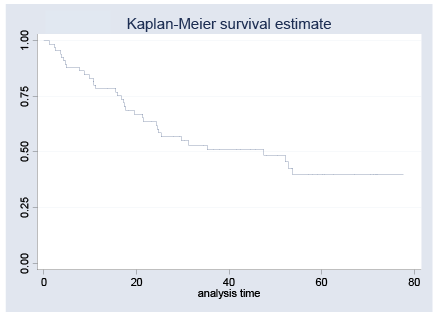
Figure 1: Overall Survival

Table 2: Clinical and Pathologic Stages
CR: Complete Response
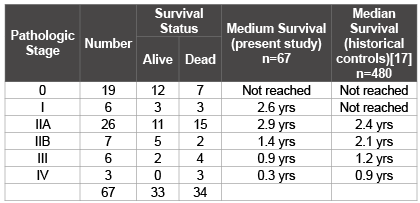
Table 3: Survival by pathological stage vs. historic controls
We next aimed to determine survival stratified by both clinical (pre-operative) and pathologic stage. (Figure 2), survival by clinical stage, shows that there is no difference in overall survival when this outcome is stratified by pre-operative stage (p=NS). In contrast, when OS is stratified by pathologic stage (Figure 3), there is a statistically significant difference (p=0.05). As stage increases, survival decreases for the 67 patients who went to surgery. Further validating this data set and these findings are the results of survival stratified by pCR, which is similar results found by both our group and other investigators (Table 4) p=0.05 [14].
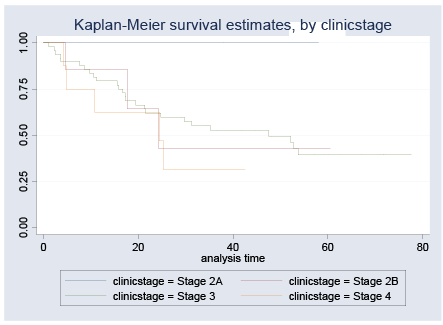
Figure 2: Survival by pre-operative stage
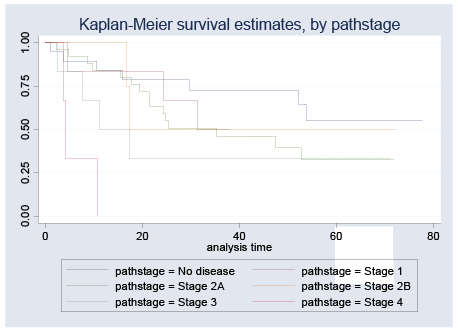
Figure 3: Survival by pathologic stage
Esophageal cancer (EC) is the sixth most common cause of death from cancer in the United States [1]. It continues to remain a difficult cancer to treat and a more difficult cancer to cure. Surgical resection is the mainstay treatment of both adenocarcinoma and squamous cell carcinoma with a 5-year overall survival (OS) rate of 15% to 22%. Given the poor long term outcome with surgery alone, various approaches are available with the goal of improving control of both loco-regional and systemic micrometastatic disease.
Patients with squamous cell carcinoma can be cured with a primary CRT [15]. In contrast, adenocarcinoma, the most prevalent type in the United States, generally requires surgical resection as part of any curative attempt. In order to improve outcomes, various schedules and combinations of chemotherapy and radiation are used. The most common approach involves concurrent chemoradiotherapy with either 5-fluorouracil (5- FU)/cisplatin or carboplatin/paclitaxel. These multimodality regimens aim to reduce both loco-regional and distant (metastatic failure)-with chemotherapy both enhancing the local effects of radiotherapy and controlling micro-metastatic disease.
Validation of this approach is provided by the intergroup study carried out by Tepper et al. [11]. In this study, which failed to accrue to goals, 57 patients were randomized to either pre-operative CRT with cisplatin and 5-FU or surgery alone. The patients treated with the tri-modality approach had a statistically significant improvement in survival. Furthermore, this study again showed that pCR to neoadjuvant CRT is associated with significantly improved survival (4.48 vs 1.79 years, p=0.002). In the CROSS trial, 368 patients were randomized to either pre-operative CRT with carboplatin and paclitaxel or surgery alone. The median overall survival for patients with SCC of esophagus was 81.6 months (95% CI 47.2-116.0) months in the chemo-radiotherapy plus surgery group vs 21.1 months (95% CI 15.4-26.7) in the surgery group (hazard ratio (HR), 0.48; 95% confidence interval (CI), 0.28 to 0.83; P=0.008). Median overall survival in patients with adenocarcinoma was 43.2 months (24.9–61.4) in the neoadjuvant chemo-radiotherapy plus surgery group and 27.1 months (13.0–41.2) in the surgery alone group (HR 0.73 [95% CI 0.55– 0.98]; log-rank p=0.038). There was a lower local recurrence rate (34% vs 14%, p<0.001) and lower risk of peritoneal carcinomatosis (14% vs 4%, p<0.001) in the group receiving CRT [16]. This shows an impact of CRT to reduce both loco-regional and systemic disease.
This study aimed to further refine the relationship between pathologic stage and survival, with the added approach of correlating each pathologic stage with outcome. The goal is to provide more refined prognostic information, which may be used also to tailor adjuvant therapy in the era in which carboplatin/paclitaxel-based CRT (i.e. CROSS approach) is widely used. As shown in figure 3, there was a statistically significant relationship between higher post-surgical stage and lower overall survival. These data demonstrate that pathologic stage, and not clinical stage, is the best predictor of survival for patients treated with cisplatin/ paclitaxel-based neo-adjuvant CRT. In addition, this correlation suggests that pre-operative CRT may impact the behavior of the disease such that survival is predicted by pathologic, not clinical stage. Comparison of our survival data to that of patients treated with surgery alone in study by Rice et al. [17] supports this finding. When compared with their data, our pathologic stage versus OS data has a similar survival outcome compared with patients treated by surgery alone. In other words, survival outcome data should be based on pathologic stage, as is the case with primary surgery, with the difference being that the addition of pre-operative CRT may impact the pre-operative prognosis by changing the stage for any individual patient.
This information has several implications for clinical practice. First, prognostic information provided to patients in the pre-treatment setting may not reflect the actual prognosis after neoadjuvant CRT followed by surgery. Second, pathologic stage may be the best parameter for determining which patients require adjuvant therapy. There is a lack of data regarding the use of adjuvant chemotherapy in patients treated with neo-adjuvant CRT. Given that the majority of these patients do not achieve a pCR, adjuvant chemotherapy may be an option to improve their survival. Third, this data provides further motivation for the search for predictors of who will most likely respond to pre-operative CRT.
This study has several limitations. Because the trial was conducted before 2009, AJCC Cancer Staging 6th edition was used to enroll patients and to classify post-CRT pathologic staging. This is different from AJCC Cancer Staging 7th edition, which is currently used in staging EC. Due to the years of the study, positron emission tomography (PET) was not routinely included as part of staging. PET scan may result in stage migration in up to 10-15% of patients by detecting previously undescribed metastatic disease. Finally, we were not able to gather data about adjuvant therapy, which might impact on patient’s survival.
In summary, this study indicates that most patients are downstaged by induction CRT. All patients with unchanged or progressive disease during CRT died. Survival correlates with pathologic stage not pre-treatment (clinical) stage, and survival by pathologic stage of patients treated with pre-operative CRT compares favorably with similarly staged patients treated with surgery alone. These findings support the use of pre-operative CRT and have implications for the selection of patients for adjuvant treatment as well as the search for determinates of response to induction CRT. Several cooperative group studies are planned to address this issue.
LK: design and MS writing
EH: Trial design, Patient accrual and data analysis
RH: Trial design, Patient accrual and data analysis
MB: Trial design, Patient accrual and data analysis
AF: Trial design, Patient accrual and data analysis
MG: Data extraction and database creation, Data analysis and statistics, Conclusion, MS writing, Decision to submit
Download Provisional pdf here
All Sci Forschen Journals are Open Access